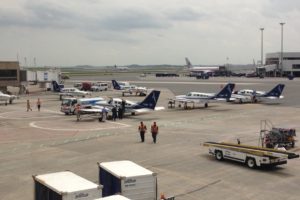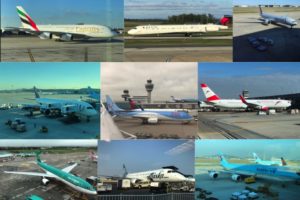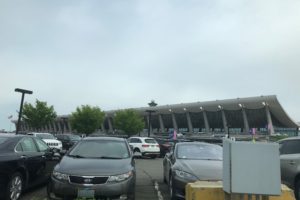Review: Everett Factory Tour & the Future of Flight Aviation Center
On August 9, 2018, I had the pleasure of attending a factory tour of the Boeing Everett Factory at Paine Field near Seattle. For those of you who do not know, the Everett Factory is where Boeing assembles all of its wide body jets – the 747, 767, 777, and the 787 Dreamliner. To get to the tour, one first has to go to the Future of Flight Aviation Center across the runway from the factory, where the tour departs from. Unfortunately, Boeing does not allow cameras, cell phones, or backpacks on the tour, as they claim that they could fall down on something and be a safety hazard, so don’t expect many pictures in this post. Overall, it was a great tour, and I learned a lot about the production of Boeing aircraft. Keep reading to learn more about why I loved it. Tickets cost $25 for adults, $15 dollars for youth, and $23 dollars for seniors. Book here for a tour of the Everett Factory.
Pre-Tour
Our tour started at 1 pm, so we got to the Future of Flight Aviation Center at around 12:30pm; half an hour before the tour. While entering the parking lot, I took some pictures across the tarmac of the airplanes almost ready to be delivered. The aircraft made most at Everett is the Boeing 787, so most of the planes there were 787s.

Left to Right: A Qantas Boeing 787-9, A Hainan Airlines 787-9, An Ethiopian Airlines 787-9, A Biman Bangladesh Boeing 787-8, A KLM Boeing 787-9

An Etihad Boeing 787-9 and a Boeing 777-F

Panorama of the Airfield

Entrance to the Museum
We went inside the museum where we went to the front desk immediately to get our tickets for the tour. We were told that we can’t take any phones, cameras, or bags onto the tour and that we would have to keep them in lockers at the museum. I am really sorry that I couldn’t take any pictures on the tour; I really would have loved to take them and share them with you. 😥
After checking out the store a bit, we headed to the place where we would begin the tour. At this point, we already had given up our phones, so unfortunately, I could not take a picture of it. Off to the left of the museum, there is a little hallway where people are supposed to wait and line up for the tour. At 1 pm sharp, tour guides started taking our tickets and we were told to go to an auditorium. We were given either a blue or red card, which would show us which tour guide we would go with.
In the auditorium, while people were entering, a promotional video showing how amazing Boeing aircraft played. When everyone entered the room, a tour guide gave us a little briefing about the tour. Around 100 people were in the auditorium when everyone arrived. She said that there will be a lot of walking and climbing up and down stairs, so anyone who can’t do that should raise their hand and request a route that requires less walking. No one raised their hand. She then told us that if we needed to drop off electronic devices or bags or needed to use the restrooms, that we should do that now, as using the restrooms on the tour is extremely difficult, and devices or bags would be confiscated if they were found on the tour. Around 20 out of the 100 people left for 5 minutes, while another promotional video was shown.
At around 1:10, the tour guide told us that if you had a blue card, that you would go to the left with her and if you had a red card, you would go with the other tour guide. I had a red ticket, so I headed to the right with our tour guide, (I think her name was) Sheila. Along with around 50 other people, we got on a tour bus while the other 50 people got on another tour bus with the other tour guide. Thus, the tour began.
The Tour:
After getting on the bus, Sheila introduced herself and the bus driver and said that the tour would be around 90 minutes long. She pointed out a 747 Dreamlifter, the airplane that carries parts to assemble the Dreamliner (see picture at the bottom of the page). We then drove around the side of the runway where we got to see a lot of 787s, including El Al’s new retro livery 787.

Photo Courtesy of El Al
We saw many other 787s and a 777F along with the paint hangers. We then approached the largest factory in the world by volume: the Everett Factory. She informed us that it was originally built to build the Boeing 747, although it now builds the 767, 777, and 787 along with the 747. Facing the factory from the apron, the left side builds the 767 and 777, the center section is used to build the 777, and the right hadn’t section is used to build the 787. The factory has six doors to the outside, all painted with murals showcasing Boeing aircraft. We got out of the bus and headed down into a tunnel under the factory. We first visited the side of the factory that created the 767 and 747.
767s and 747s:
There are many tunnels underneath the factory used to get from place to place easily. The stairs down there were actually pretty steep. When we got down there, we walked about half a kilometer until we reached a 747 sign and an elevator. We took an industrial elevator capable of carrying every one of the 50 of us up to a viewing point. At first glance, you just saw how huge the factory actually is. It’s extremely tall at the same time as being enormously massive having a huge width and length. We caught a glance of the other tour group of the 1 o’clock section right behind us then. We took up the elevator to the viewing level. After a little lounge area, we walked in a little viewing loop over the factory.
On the right side, we saw the manufacturing of pieces of the aircraft such as the horizontal and the vertical stabilizers. In the factory, there are many cranes that can hoist parts of the aircraft from one section of the factory to another. On the left side of the viewing point (facing the apron outside), we saw the final assembly of a 747-8F going to UPS and two KC-46s (tankers) in final assembly which will go to the USAF. Unfortunately, there probably won’t be any more 747s to be delivered to a commercial airline, and there aren’t that many more cargo orders. Boeing only makes a handful of them a year, so the 747 probably will only be in production for the next 4-5 years, most of them going to UPS. If you would like to see a 747 being made, visit soon! We then saw a video of a 747 being made as a 2 minute time lapse. Next, we went back down the elevator and walked to the exit, punctually at 1:45.
777s and 787s:
We hopped on the bus again, and passed the 1:30 tour groups coming to where we came from in the factory. We then headed to the other end of the factory where the 787s and 777s are produced. Sheila stated that the Boeing 787-8 and Boeing 787-9 are assembled here, while the 787-10 (the newest variant) is only created in Charleston. Boeing now produces around 14 Boeing 787s per month, which is an impressive rate! Boeing also makes around five 777s per month. Upon entering, we saw a TV truck, and were told that we might run into a CNN TV crew on the tour. We entered another tunnel exactly like the one that we were in earlier and entered another industrial elevator identical like the one we saw earlier. After exiting the elevator, we entered another lounge type area, and headed left to the 787 production line. 4 787s were there at the time in the production line (all 787-9s): Air New Zealand, Korean Air, and Avianca 787s (the fourth one was unrecognizable.
After admiring the 787s, I looked down to see a few open offices above the 787s. To the left of the offices, I saw the CNN crew, with Richard Quest! For those of you who don’t know, Richard Quest runs the CNN International show Quest Means Business, and he also is a pilot. He is basically CNN’s aviation expert. I saw that he was on the air right when we got there. I later found out that he interviewed the Boeing CEO Dennis Muilenburg earlier (although to my knowledge, I did not see him). Apparently, Richard Quest interviewed him about the “trade war” with China and how Boeing responds to it, and about the importance of the aviation market in China.
Click here for the interview between Richard Quest and the Boeing CEO. Also, CNN took a picture of the factory at the exact same time as I was there, so see that below.

Photo Courtesy of CNN
After seeing Richard Quest from above and looking at the 787s, we headed to the other side of the viewing point, to see the 777s. I saw three 777s: one Boeing 777-200F for Qatar Airways, and one each Boeing 777-300ER for Turkish Airlines and for Emirates. After that, we headed back out to the bus and back to the museum. At the bus, our tour guide Sheila gave examples for how big the actual building was; all of Disneyland could fit within the factory, with even more extra room! We then passed by the painting hangers and parking, we saw the delivery center, which has two jetways where wide bodies are delivered to customers. Unfortunately, there were no planes parked there today. Then, we passed by the fence where planes’ engines are tested or as she called, the “community relations fence.” I was honestly hoping that we would drive by all of the newly constructed 787s (see pictures above), but that was not part of the tour. We then were back at the museum, after a fantastic tour of the factory.
The Museum:
We decided to check out the Future of Flight Aviation Center after the tour. It really is not that big, and I don’t really think anyone goes there if they are not taking a tour that day. We first got our bags and phones back (so I could take some more pictures), and we headed up to the observation deck of the factory first. We got a great view of the Dreamlifter and of the planes across the tarmac.

There were only 4 Dreamlifters ever created, so we got to see 1/4 of Boeing’s Dreamlifter fleet.

Finished KC-14s

Ethiopian Airlines and Biman Bangladesh 787s

A KLM 787-9 and the EL AL Retro Livery 787-9
After that, we checked out the museum below, where there were a few planes hanging from the ceiling and exhibits showcasing a model of a Space Station Module and cutouts of aircraft. It also had an aviation themed play section for young children, although as you can imagine, that was not too interesting to me.



The museum bit wasn’t super interesting for someone who lives half an hour from both National Air and Space Museum campuses in DC, so after around 20 minutes of looking around, we were done with that.
Conclusion:
It was an amazing tour because we got to see the largest factory in the world where some of the largest aircraft are produced. It was a truly special experience to be able to see so many planes in production and to actually see where so many legendary aircraft began their life. My one major complaint was that we couldn’t take any camera or phone to take pictures because I (along with everyone else) could have gotten some fantastic imagery of 787s being built. Overall, if you are an aviation enthusiast, I would fully recommend getting an Everett factory tour if you are living in or visiting Seattle, as it was truly a once (although I will probably visit again) in a lifetime experience.
Have you ever gone on a Boeing factory tour? Share about your experiences below!




